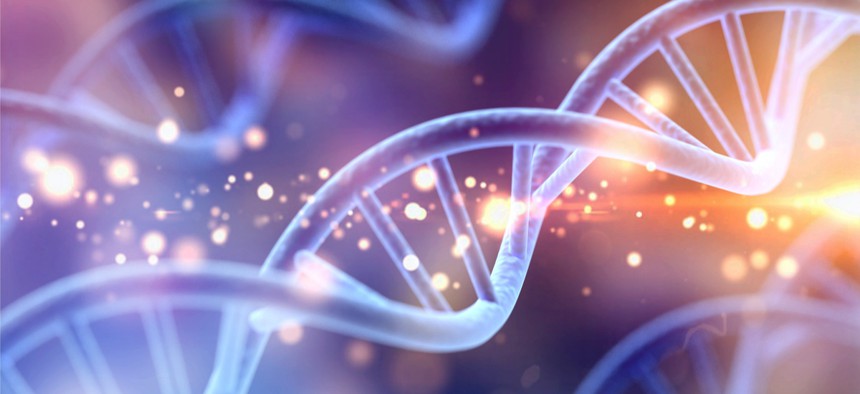This New Advancement in Interpreting DNA Evidence Could be a Game Changer

A new type of software can help crime labs better interpret DNA evidence. SHUTTERSTOCK

Connecting state and local government leaders
COMMENTARY | Probabilistic genotyping software has helped forensic labs close more cases and exonerate individuals wrongly accused of a crime.
The development and implementation of forensic DNA typing more than 30 years ago has been a boon to law enforcement, the judicial system and society. The unprecedented expansion of biological evidence that now can be analyzed has led to more arrests, convictions, exonerations and re-openings of cold cases. This success, though, has created an increased demand and additional focus on processing more challenging samples to assist investigations.
Consistent with the many technological advances that have occurred within the field of forensic genetics, the use of forensic DNA probabilistic genotyping (PG) software can help meet these demands. PG software is the latest advancement that has substantially improved the ability of federal, state and local crime labs to interpret DNA evidence, particularly regarding those DNA profiles that may be low-level, degraded and/or mixtures. Over the last eight years, PG software already has been used in more than 220,000 cases worldwide.
PG software helps in linking a genetic sample from crime scene evidence to a person or persons of interest. It works by first analyzing genetic profiles from the evidence and subsequently comparing or considering the person of interest. This process provides a probability on whether the DNA evidence generated supports that the person of interest was at the scene versus if an unknown person was. The statistical strength provides investigators with relative values of these two probabilities to assist in linking or excluding the person of interest.
As a result of this enhanced capability, those labs using PG software have increased the number of interpretable DNA results in a range of cases like sexual assault, gun violence and cold cases—providing clues that were not available at the time those cases occurred.
PG tools have been equally effective in excluding individuals wrongly accused of crime. In fact, a man who was wrongly convicted of murder in Texas has now been proven to not be connected to the DNA evidence. PG software developed a candidate DNA profile from the evidence that authorities checked against CODIS, the system that houses the nation’s convicted felon DNA profiles, to assist in identifying the likely source of the DNA evidence.
PG software has strong scientific support for its reliability and validity. Despite its successes and its demonstrated ability to assist with the interpretation of DNA results, the admissibility of results obtained using PG software has been challenged in courts. This is expected (rightly so) given that it is newer and complex. However, the scientific underpinnings, validation studies and peer-reviewed publications supporting PG software use, have led to the vast majority of local, state and federal courts either admitting such evidence or denying motions to exclude it, concluding that such DNA analyses are admissible under the governing standards for admissibility of scientific evidence.
With all of its benefits, there are limitations to PG software. It cannot, for example, interpret all DNA profiles. Some profiles simply have too little information or are far too complex to interpret. There also is a human component to the generation and interpretation of DNA results which must be addressed. Humans are part of the DNA interpretation process and must review the results to ensure they make sense. Further, humans can and do make mistakes, which can be confounded if software limitations are not understood. In some situations, individual bias can have an impact. Proper training is imperative to be able to take advantage of the benefits of PG software while reducing errors of interpretation, some of which can be quite critical.
While not perfect, PG software represents a substantial improvement over all previous processes to interpret DNA evidence. It has had and continues to have a profound impact on the work being done by forensic labs, providing reliable data from a broader range of DNA evidence and contributing results that can assist investigators and the judicial system. That, in turn, is playing a key role in crime resolution and exclusion of individuals who have been wrongly identified as the source of crime scene evidence.
Bruce Budowle, PhD, for the past 12 years, has been a professor and director of the Center for Human Identification at the University of North Texas Health Science Center, where he is involved in casework, research and validation of biotechnology and molecular genetics methodologies and teaching. Dr. Budowle also has 26 years of experience in forensic genetics with the Federal Bureau of Investigation. He served as research chemist at the Forensic Science Research and Training Center at the FBI Academy; was adjunct professor in the School of Continuing Education, University of Virginia, on the FBI Academy campus; was chief of the Forensic Science Research Unit in the Laboratory Division of the FBI Academy; and was a senior scientist in biology in the Laboratory Division of the FBI.

NEXT STORY: Lawyers Who Were Ineligible to Handle Serious Criminal Charges Were Given Thousands of These Cases Anyway




